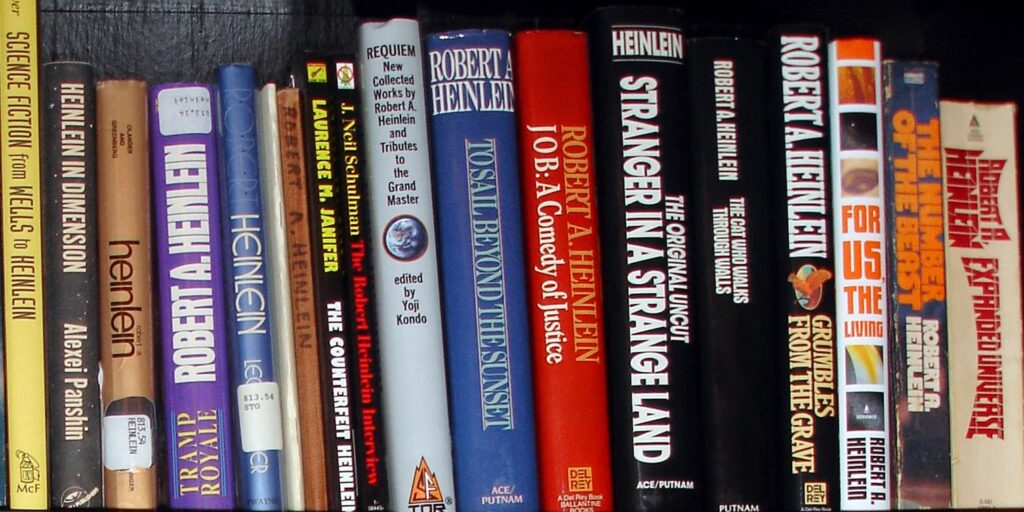years. When he was alive, I watched
constantly for his next publication, and I have read nearly everything he has
written and a great deal of what has been written about his work. Learning only recently that there was an
official biography about him leaves me rather late in following up my past
diligence, but I am glad I didn’t find these two volumes by William H. Patterson, Jr.,
until this month. Now was the time for
me to read about Heinlein’s writing experience and process.
reading these texts. I found numerous levels of understanding about the
process, organization and publication of writing, working with agents and
editors and publishing in general (though, of course, there have been changes,
the human element should not have altered much). There was also the personal element of being
a writer, champion of ideas and role model that was just as provocative and
informative, but that will be for another post.
process, important to any writer’s effort to write well.
- Use index cards to organize and maintain ideas. Sure there are numerous electronic
organizers, but I like the inspiration that comes from being able to shuffle, redistribute and overlap
ideas on a 3×5. I am definitely going to work with this
approach. Heinlein used index cards to jot down ideas and even carried them around with him when working on a story. When enough ideas started to
come together, they were kept in a group, and he would refer back or add to them
as his story grew. The system gained
structure as his ideas and completed writing grew. So they (his wife Virginia Heinlein came up with his indexing
structure) set up a filing system that
categorized the ideas and identified each published or work in progress. Each book or WIP acquired its own indexing
number. I am going to use his system to
build one that will work for me. - Gather research: he was constantly researching
science, technology, engineering, etc., to ensure accuracy in his writing. I do
research, but I think I need to develop this process more and in a less
isolated manner – both broad and deep so there is more overlap and more
connections built and therefore more material for writing. - Read up on a lot of topics: Heinlein was not
afraid to read a tome far above his level of understanding. He was known to
seek out specialists in his field of interest and have them teach him what he
needed to know so he could understand in-depth writing in the field he was
curious about. This is an area I need to
work on. - Gather a cadre of authorities to tap. No explanation needed here.
- Let ideas stew, even for years. Some books half written sat around waiting
for the right idea, the new understanding or experience before they were ready
to be completed. He fought for every
piece he wrote to get to its end, but he also was ready to recognize when
something just was not ready for prime time. - Have an overall plan for a book. For some writers this is not a useful tidbit.
But for me it is. I realize more and more
that I am playing catchup with my stories about two thirds through. I knew where I wanted to start and where I
thought it would end. I often have a set
of events I expect to fill the middle with on the way to start and finish, but
I realize at that 2/3rds point that I failed to consider the reader interaction
that goes with the connecting of these two points. I think that is what that overall plan means
to me. I need to have the bones
organized earlier for my books. Even if
I deviate in the process of writing, I will have still worked out much of what
the intercourse will be between the story and the reader that is essential. - Use mythologies and connecting images or
principals in a work. The underlying
pieces are so essential.
Heinlein would work out what mythology or images he wanted to imbed in his
stories to link events and ideas together within a work. - Making use of personal experience. I suppose
this falls under “write about what you know,” but I think it is
deeper than this, and I think writers naturally incorporate their own
accumulated bundle of tragedy, comedy and drama. We all can take an experience
and pick out the magic pieces that add depth and authenticity to our work. - The benefit of a participating spouse: providing
ideas and feedback and being a resource of information. Heinlein was fortunate that both ex-wife
Leslyn Heinlein and his wife Virginia Heinlein were willing to be a part of his
writing process and business. Not all writers have a spouse who is willing to
provide this deep of a commitment. Mine
hits at about the 5 percent when it comes to involvement, but he is
tremendously supportive. He uses the word “work” when he asks what I
am doing as I am typing on the computer.
He’ll say, “Is that for school or are you working?” I love that. And he’s growing in this
area. After all, he is the one that made
sure the plans for our house included an office for me. - Reading inside and outside your genre. Heinlein kept up on both scientific writings
as well as contemporary fiction. He believed it
advanced his writing quite a bit and resulted in his hybrid Science Fiction
style which ultimately changed the scope of the genre. I write also contemporary short story and poetry, read for pleasure and
read for study, but I could still enlarge on this. (I read three biographies in
the last month, and that is more of that genre than I normally read in a year.) - Don’t be afraid and even seek to write something
different, challenging or disruptive.
Several of Heinlein’s works, according to his bio, he did not expect to be
accepted for publication. They were just too different: Stranger
in a Strange Land, Time Enough for Love, and Number of the Beast. But they were accepted and each were met with near instant success. - Don’t be afraid to create your own genre. Heinlein
moved away from the strict confines of what constituted Science Fiction. (What
was new and different in his time is very much the norm of our own.) - Submit to small presses and lower-end magazines
to begin with. Submit?! Okay, I am
working up to this. There is a time commitment here because of the research,
selection process and keeping track of what is out and where it has been. I am
going to squeeze it in. I promised myself and I am going to do it. So
Submit! - Submit repeatedly and continuously. Since we’re
on the subject, Heinlein just kept things heading out the door until it found a
buyer. Just keep flinging them off the
merry-go-round until they land on their feet. - Take all criticism under consideration and
follow what feels right. I like this
especially about Heinlein. His stories
had to meet his internal critic and his external (spouse). Once it passed those two road blocks, he
fought for it. He took criticism that
would make a work better but routinely refused to castrate or turn a work into
weak milk. None of my current work is a
challenge to society being largely written for entertainment, so this mandate does not apply too heavily to my work.
But should I write something that pulls hair, I won’t let myself be forced to
back down in order to keep a segment of society from having to take off their
rose-colored glasses. - Join groups that augment or support your
genre/subject/intentions. Heinlein
wasn’t much for writing groups, but he did form his own quasi-feedback
groups. Lucky stiff, he had Pohl,
Azimov, Savage, the Smiths, Bova, the Sturgeons etc. They talked shop, shared ideas, helped develop
plots, kept each other informed of new technology and writing aids. Heinlein once bought another writer a
typewriter because he felt it had been such an aid to lightening up his work
load and time spent in production. - Keep organized files and sift through them. This is much related to an earlier point, but
the reason why it is separate is that one must do more than just organize the
works and ideas. You must review them,
add and combine. If they sit in a drawer
than all they will ever do is sit in a drawer.
#Heinlein
#writingprocess

